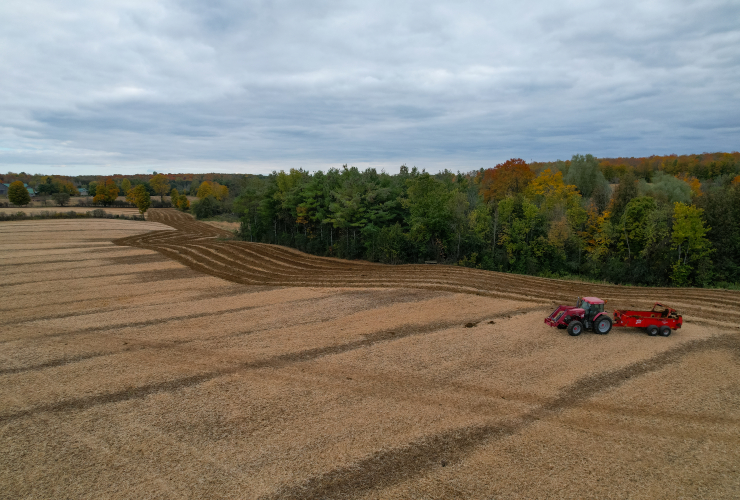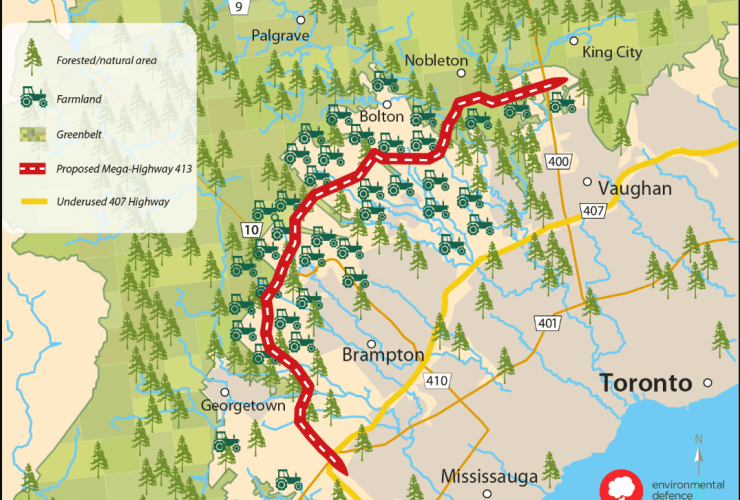The Ontario government can move forward with the construction of a contentious highway after Ottawa gave up its lengthy battle Monday over a federal environmental assessment.
In a joint statement, the federal and provincial governments announced an agreement that will allow the Ford government to commence work on Highway 413, which would connect Milton and Vaughan.
However, the new memorandum of understanding signed between Ontario’s Ministry of Transportation and the Impact Assessment Agency of Canada establishes a joint working group of provincial and federal officials who will recommend “appropriate measures” to minimize environmental impacts in areas under federal environmental jurisdiction.
“This agreement shows Canada and Ontario’s ability to work together while recognizing their shared jurisdiction on matters to do with the environment,” said Environment and Climate Change Minister Steven Guilbeault in a joint statement shared with Canada's National Observer. “It also ensures federal interests will be maintained on the protection of species while offering Ontario, in light of the recent Supreme Court’s decision, a greater level of clarity around the review process for the Highway 413 Project.”
Reacting to the agreement, advocacy group Environmental Defence urged the federal government to prioritize environmental protection and swiftly redesignate Highway 413 for assessment under the updated Impact Assessment Act as soon as it is in force.
“Problems with the current Impact Assessment Act always meant the current assessment designation of Highway 413 would eventually need to be discontinued and reinstituted under an updated version of the law,” said the group’s statement. “The Ontario public’s expectation is that Highway 413 will be re-designated fast enough to ensure that the provincial government does not have time to destroy key habitats or waterways during a gap in protections.”
In 2021, former federal environment minister Jonathan Wilkinson ordered an assessment for Highway 413 due to potential impacts on three endangered species. Ontario could not proceed with construction until the federal government was satisfied that measures were in place to mitigate potential harm to protected local species.
The proposed 60-kilometre highway, also known as the GTA West Corridor, aims to alleviate congestion in the fast-growing Greater Toronto Area. However, it would cut through 2,000 acres of farmland, cross 85 waterways, pave nearly 400 acres of protected Greenbelt land, disrupt 220 wetlands and impact the habitats of 10 species at risk.
Last October, a ruling by the Supreme Court of Canada found that Ottawa's Impact Assessment Act (IAA), which regulates major development projects, is largely unconstitutional because it stepped into areas under provincial jurisdiction. The IAA, initially known as Bill C-69 and enacted in 2019, permits federal regulators to assess the potential environmental and social impacts of diverse resource and infrastructure projects.
Following the Supreme Court decision, the Ford government filed a judicial review to prevent the federal government from ordering assessments on crucial infrastructure projects, including Highway 413.
“Today’s announced agreement provides Ontario the certainty we need to move forward with Highway 413,” said Prabmeet Sarkaria, Ontario’s minister of transportation. “I want to thank the federal government for meeting us at the table and collaborating on the environmental protections needed to get the project started. In the coming months, we will move ahead with procurement to get shovels in the ground on key interchanges of the project, bringing us one step closer to getting it done.”
It’s never been more important to build roads, bridges and highways that drivers rely on, Sarkaria added.
Environmental advocates have long raised concerns about the environmental impact of the proposed Highway 413 for southern Ontario. They argue that building roads creates carbon emissions and that 413 will accelerate the destruction of species' habitats and disrupt sensitive ecosystems, including wetlands, forests and prime farmland while emitting tons of CO2 into the atmosphere.
The Environmental Defence statement said failure to redesignate Highway 413 for a future impact assessment would be “a willing and reckless betrayal of everyone in Ontario who is experiencing unprecedented attacks on their communities by the provincial government and has trusted federal MPs to do their job and protect the environment rather than colluding with the province in its destruction.”
Research commissioned by Environmental Defence suggests that Highway 413 would contribute over 17 million tonnes of additional CO2 emissions by 2050 — coinciding with Canada's net-zero emissions target.
The estimated cost of building the highway exceeds $6 billion and would significantly impact historic Indigenous sites, while destroying rare habitats of at-risk and endangered species, according to the group.







Comments